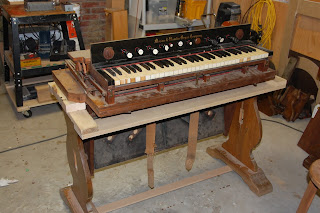Restoring a Reed Organ - Part 10: Fixing the Splinter

As mentioned in a previous installment, we learned the hard way that Mason and Hamlin made it difficult to separate the bellows board from the bottom of the wind chest. They glued that sucker on, and good! I'm sure this provided an excellent seal, but many other manufacturers simply used a leather gasket and some screws (or so I'm told). We tried as carefully as possible to remove the board, but we ended up with a signficant large splinter coming away from the windchest and several smaller ones as well. The bottom of the chest is pictured below, with the damage. Needless to say, we were feeling a bit discouraged, and quite a bit like butchers. I was afraid to go onto the Reed Organ discussioin page to ask for help as I thought maybe the Reed Organ police might come and confiscate this wonderful instrument from the hands of the Philistines. I quietly emailed Rodney Jantzi, who encouraged us and gave us some advice on pushing forward. As I...


